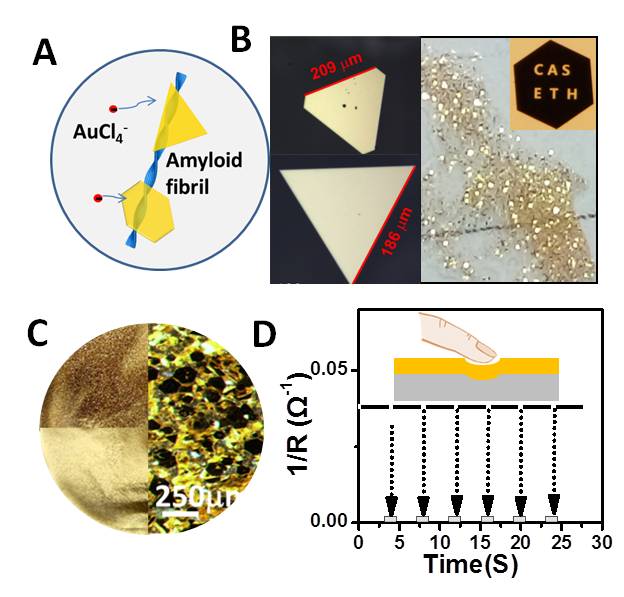Bio-based Nanofibrils: Extending Au 2D Nanomaterials to Macroscopic Scale
The fascinating roles of two-dimensional (2D) nanomaterials in natural super-strong bio-composites (i.e. aragonite platelets in nacre and apatite platelets in bone) have aroused great interest in scientific communities to synthesize their artificial counterparts with controllable geometric and physical properties. The quantum 2D confinement of electrons recently revealed in graphene nanosheets further inspires to explore 2D metal nanocrystals with intrinsic anisotropic properties and quantum size effect. Among them, 2D Au nanocrystals stand out not only due to their unique structure- and environmental-dependent properties, but also due to their rapid development in synthesis approaches and emerging applications in optics, mechanics, electronics, catalysis, sensing and biomedicines. Though much endeavor has been made to achieve a shape/size controlling synthesis, the lateral dimension of 2D Au nanocrystals had been long limited within the microscopic scale. In 2015, Prof. Chaoxu Li at the Qingdao Institute of Bioenergy and Bioprocess Technology (QIBEBT), Chinese Academy of Sciences, reported that amyloid fibrils, a unique type of protein assembling nanostructures, may help extend the lateral length of 2D Au nanocrystals close to half a millimeter.
Due to super aspect ratio and mechanic properties of amyloid fibrils, Prof. Li started in 2009 to construct various functional materials (e.g. hydrogels, artificial bone and graphene-based paper) based on amyloid fibrils when he worked in Swiss Federal Institute of Technology in Zurich. Later he and his colleague created a hybrid material out of Au nanocrystals and amyloid fibrils that looks like a wafer-thin gold leaf and could be used in applications as food decoration, cosmetics and jewellery industry. Here he and his colleague further prepared Au flakes with different planar area and thickness by a simple one-step method. The work has been published in Advanced Materials on 5 February 2015 (Figure 1).
These single-crystal gold microflakes have an unprecedented planar area over 104 μm2 and thickness larger than 100 nm. Their typical length out of nanometric scale has immediately opened a new scenario in applications to avoid the increasing health concern of nanomaterials. In culinary applications, gold has an approved E-number code (E-175) in U. S. and long been used to decorate desserts, drinks and other specially prepared foods, as well as cosmetic products. Their super optic golden surfaces also fulfill the demand in clock and jewelry industries. Because of their atomically flat surfaces, they can be considered as a novel alternative to gold foil, to reduce the cost of using gold.
The unprecedented macroscopic dimensions also offer a number of advantages in applications as optical nanocircuitry, single-crystal electronics, nanoantenna, sensing and imaging devices. Moreover, flexible conductive films are fabricated by incorporating them into polyurethane, which exhibit a unique strain-controlling conductivity behavior.
The research project was supported by the Ministry of Science and Technology of China, the National Natural Science Foundation of China and Qingdao Municipal Science & Technology Program.
 |
|
Figure 1. A) Schematic synthesis procedure of macroscopic single-crystal gold microflakes from chloroaurate ions and amyloid fibrils. B) Images by visual observation (grid size 0.9 ×?0.9 cm2) and optical microscopy of Au microflakes. C) Image of front (upper part) and back (bottom part) view of free-standing polyurethane films (thickness 100 μm) with microflakes. D) Variation of in-plane electric resistance of the film under finger touch. (Image by Biomimetic Smart Material Group) |
Reference: Macroscopic Single-Crystal Gold Microflakes and Their Devices, Advanced Materials, 2015, 27: 1945.
Contact: Prof. LI Chaoxu
Qingdao Institute of Bioenergy and Bioprocess Technology, Chinese Academy of Sciences
Email: licx@qibebt.ac.cn